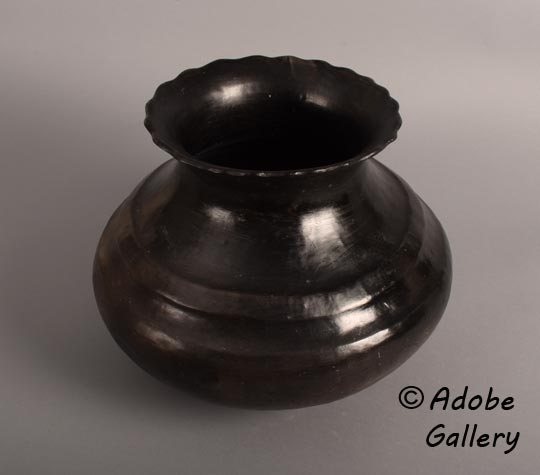Sara Fina Tafoya Traditional 19th Century Tewa Shape Water Jar
+ Add to my watchlist Forward to Friend
Forward to Friend
- Category: Historic
- Origin: Santa Clara Pueblo, Kha'p'oo Owinge
- Medium: clay
- Size: 11” height x 13-½” diameter
- Item # C4942K
- Price: $8750
This jar displays the most beautiful and graceful shape of any Tewa wares. It is unquestionably a Sara Fina Tafoya creation. It exhibits her hand in every respect — shape, quality, and fluted rim. It was constructed of native Tewa clay and coil-formed in the traditional pueblo manner.
Sara Fina scraped her vessels with corncobs to smooth the vessel wall before applying slip. She is known to have detested the use of commercial sandpaper. Her earlier works show evidence of this method. Later, her vessel walls were smoother, as if sanded, but, if so, another member of her family did the sanding because she would not.
The double shoulder just above the mid-section bulge rises to a graceful curving neck extending upward to the flared-out rim. The entire vessel was slipped, stone polished, and fired to a beautiful dark black. The bottom is concave, and the rim is fluted. The jar is circa 1915. This vessel shape is the one associated with Sara Fina and is the one that has made her famous and the best-known potter from Santa Clara Pueblo of the nineteenth century. It has been stated that the fluted rim represents rain and the double shoulder represents a double rainbow.
Nineteenth-century pueblo potters, almost always female, did not seek fame or fortune. They went about their daily tasks of raising children, cooking for the family, and making pottery, sometimes for use in their homes and other times for sale just for extra funds for daily needs. It is not in the nature of the pueblo people to be seen as better at something that others of their village. They all worked for the benefit of the clan, family, village, and neighbors. Everything was for all, nothing for self.
Fame and fortune were bestowed on some potters because that is the way it is perceived in the Anglo culture. Collectors want to collect from artists who are known by others to be exceptional at their work and this then does select individuals for particular attention. Names of women potters such as Nampeyo, Maria Martinez, Helen Cordero, Margaret Tafoya, Martina Vigil, and Lucy Lewis come to mind when thinking of famous potters today. Of the older generation, there were Tsayutitsa, Mary Histia, Arroh-ah-och, Toña Peña Vigil, Sara Fina Tafoya, and others. None sought fame but they earned it and it was bestowed on them by us. That is why we recognize their names.
One of the most famous nineteenth-century Santa Clara Pueblo potters was Sara Fina Tafoya (circa 1863-1950) Autumn Leaf, followed in time by her daughter Margaret Tafoya. Sara Fina was an exceptional potter from about 1880 to 1950 and she made large, magnificent pottery jars, some in excess of three feet tall. Because she lived and worked into the first half of the twentieth century, her name is familiar to collectors today and her pottery is easily recognizable. One of her signature vessel shapes is the exaggerated-width water jar.
Condition: It appears that this was used as a water jar. It had exfoliation on the lower interior and exterior. The exfoliation was stabilized and concealed to maintain visual integrity. Very minor rim repairs were completed.
Provenance: this Sara Fina Tafoya Traditional 19th Century Tewa Shape Water Jar was part of the following former and ckurrent collections:
- ex collection of Richard M. Howard, Santa Fe, NM
- ex collection of Robert Nichols, Santa Fe, NM
- current collection of a client of Adobe Gallery
Recommended Reading: Born of Fire: The Pottery of Margaret Tafoya by Charles S. King, et al.
TAGS: Santa Clara Pueblo, Historic Pottery, Southwest Indian Pottery, Sara Fina Tafoya, Margaret Tafoya, Joseph Lonewolf, Grace Medicine Flower

- Category: Historic
- Origin: Santa Clara Pueblo, Kha'p'oo Owinge
- Medium: clay
- Size: 11” height x 13-½” diameter
- Item # C4942K
- Price: $8750
Adobe Gallery Recommended Reading
Adobe Gallery Recommended Items
If you are interested in this item, we would also like to recommend these other related items:



